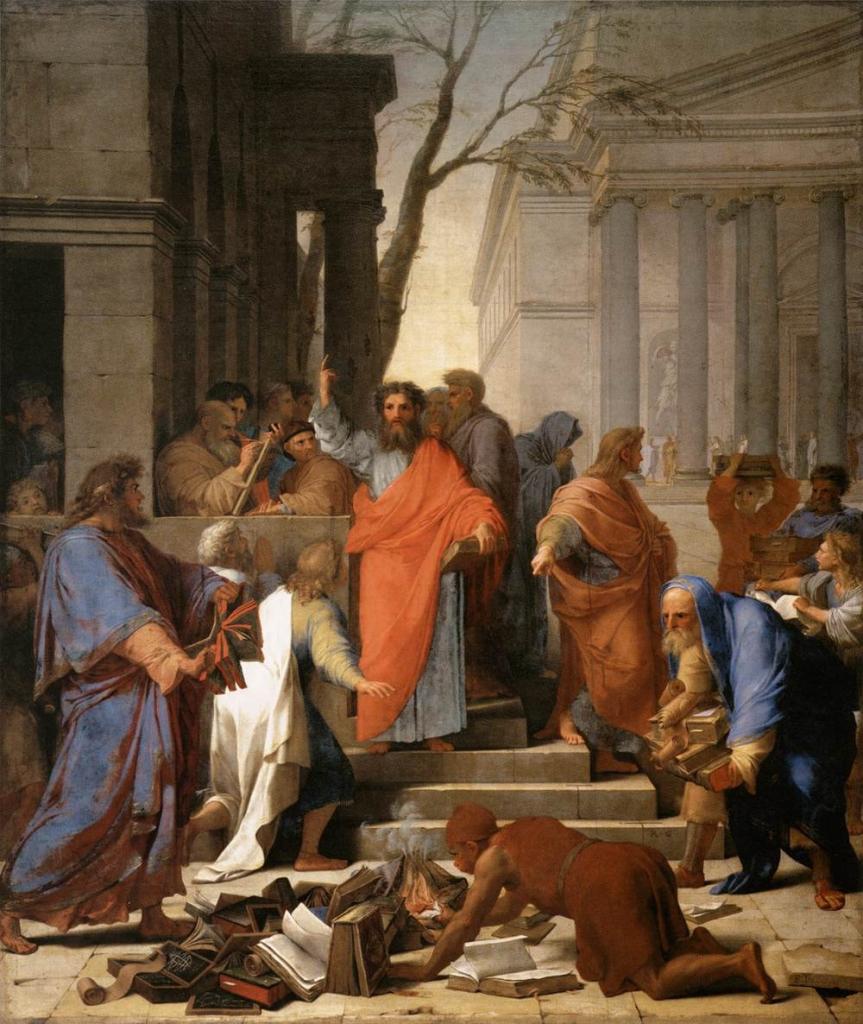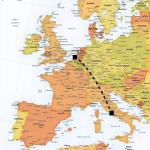Much of Christian theology and doctrine grows out of St. Paul’s letters to various congregations identified by their location, including those in Rome, Corinth, Philippi, Thessaloniki, and other places. We do not have his letters to the people of Damascus, or Caesarea, or Tyre, or Ptolemais, or plenty of other places with which he certainly had associations. Why is that? And why on earth are there no letters to the Jerusalemites? That did not mean that he was a wildly selective or haphazard correspondent. If we think about the reasons why some documents survived, while others didn’t, then we understand just why the New Testament looks as it does, and why we tend to draw our mental maps of where early Christianity flourished. If we ignore these political and military factors, we are missing a crucial part of the story.
In a couple of other blogs, I suggested the way in which the corpus of Paul’s letters as we have it was collected. The process went like this:
1.Around 90AD, somebody, let us call him Luke, wrote the Book of Acts, but in so doing, he had no awareness of the existence of Paul’s letters, and had read none of them. If he had, his account would have been very different. At this point, Paul’s letters did not exist as a collection. Arguably, none were known outside particular localities.
2.Somebody else read Acts and was really excited by it. The person might have been called Theophilos, or else that was a pseudonym that Luke addressed to somebody who bore a different name. Or perhaps it was someone in that household, perhaps Theophilos’s wife. Theophilos was a powerful and prestigious person, who would have had a secretarial staff. If it was not that Theophilos known to Luke, it was somebody very much like him.
3.That person set off to investigate all the places cited in Acts to see if they had any correspondence related to Paul. Presumably, that meant sending lots of letters of inquiry, but personal visits might have followed. In a few cases, the searchers hit paydirt, in others they found nothing. Damascus and Caesarea are obvious examples of places mentioned in Acts as being closely connected with Paul, but which produced no known documents. So is Jerusalem.
4.The collection of letters became our Pauline epistles in the New Testament. From the second century, people start valuing and quoting these rediscovered letters.
(See my earlier posts for the detailed argument).
There is no reason to believe that the canonical letters that we have are in any sense representative of everything Paul wrote, which might have run into hundreds or thousands of separate letters and tracts. He was a compulsive correspondent. Nor need we believe that the people in Thessaloniki, say, were better record-keepers than those in Damascus or Tyre or Jerusalem, or that they cared more about Paul, so much so as to keep his letters as valuable counsel and even as spiritual treasures, while others did not. Yes, the letters that survive were mainly directed to churches that he had some role in founding, but he must have corresponded widely with other congregations where that was not the case – Rome, most evidently. We would love to have his side of the furious exchanges with the mother church in Jerusalem.
Why, then, were these lost letters lost?
The answer to that is quite simple. Paul probably died around 64/65AD. Very shortly afterward, during the early years of the Jewish Revolt against Rome (66-73) savage inter-communal violence broke out across the Levant, and in Egypt. Jews attacked Gentiles and slaughtered them in large numbers. Gentiles did the same to Jews, eradicating their communities and settlements that had lasted for centuries. Indeed, the accounts of these massacres in Josephus’s Jewish War are horrendous to the point of being unreadable. If we look at the places described as marked by the most savage violence, where Jewish communities were extirpated, several of the worst massacres and orgies of destruction occurred in cities mentioned in Acts. Moreover, these almost certainly contained followers of Jesus, who would have retained letters by Paul. Those letters would have been lost when Jewish quarters were burned out. In contrast, no such massacres are known in Corinth, Philippi, Thessaloniki, and the other centers where letters were preserved.
Put anther way, the Book of Acts tells of Paul’s doings in three main regions, namely Asia Minor, Greece, and Syria/Palestine. With one conspicuous exception, namely the city of Antioch, all the centers that Acts identifies as the scene of key events in Syria/Palestine had their Jewish and Jewish-Christian populations uprooted or annihilated between 66 and 73. None of the centers in Greece or Asia Minor suffered similarly. That’s the crucial difference.
We look at Caesarea Maritima, an extraordinarily important center that was second only to Jerusalem in the Palestine of that era. Caesarea features regularly and pivotally in Acts, and Paul must have had many correspondents here. Surely, “Theophilos” must have inquired there, but the situation was quite hopeless, as Caesarea was one of the first battlefronts in the revolt. The city had long been a microcosm of the region’s ethnic divisions. As tensions rose, some Greeks sacrificed doves outside a synagogue, and the offense caused was magnified when Roman authorities failed to intervene. Open war was soon under way. After the extremist Jewish coup in Jerusalem in 66, the Gentiles of Caesarea slaughtered their Jews. Josephus says that “in one hour’s time, above twenty thousand Jews were killed, and all Caesarea was emptied of its Jewish inhabitants; for Florus caught such as ran away, and sent them in bonds to the galleys.” Caesarea soon became the key operational base for Roman forces suppressing the Revolt.
As so often in such instances, we can rarely tell just who started a cycle of massacres and tit-for-tat revenge. After the Caesarea massacre, Jews retaliated against Gentile settlements across the country, devastating the villages and towns of the “Syrians” and burning and massacring across the Dekapolis. Gentiles struck back against Jewish communities that they feared might be nurturing potential rebels and genocidaires in their midst. The insanity spilled outside Palestine’s borders. Inter-communal rioting in Alexandria escalated until the Romans sent in regular forces, who massacred the substantial Jewish Quarter. “No mercy was shown to the infants, and no regard had to the aged; but they went on in the slaughter of persons of every age, till all the place was overflowed with blood, and fifty thousand of them lay dead upon heaps.” That, by the way, is why we know so pathetically little about the earliest Christianity in Alexandria, and in Egypt more generally.
Damascus slaughtered its Jews, allegedly ten thousand in number.
Josephus goes on:
Besides this murder at Scythopolis, the other cities rose up against the Jews that were among them; those of Ashkelon slew two thousand five hundred, and those of Ptolemais two thousand, and put not a few into bonds; those of Tyre also put a great number to death, but kept a greater number in prison; moreover, those of Hippos, and those of Gadara, did the like while they put to death the boldest of the Jews, but kept those of whom they were afraid in custody; as did the rest of the cities of Syria, according as they every one either hated them or were afraid of them; only the Antiochians, the Sidonians, and Apameans spared those that dwelt with them, and would not endure either to kill any of the Jews, or to put them in bonds.
What about Jaffa/Joppa, which is also so significant in Acts? Roman forces “took the city with ease; and as the inhabitants had made no provision beforehand for a flight, nor had gotten any thing ready for fighting, the soldiers fell upon them, and slew them all, with their families, and then plundered and burnt the city. The number of the slain was eight thousand four hundred.” We don’t have to credit the specific numbers to believe that horrific massacres occurred, probably with few survivors. The Nazi-era phrase for the resulting situation was “Jew-free.”
After striking the Jews, the Gentiles targeted the Judaizers, tous Ioudaizontas, an intriguing word. It might refer to Gentiles sympathetic toward Judaism who had not undergone full conversion, but it might also include Gentiles attracted to the rising Jesus movement, which at the time was viewed as a Jewish sect. This was neither the time nor the place for people who straddled the religious and political boundary and wanted no part in the reciprocal mass murder. Reportedly, the early Christian church of Jerusalem responded to the crisis by relocating across the Jordan, to the Dekapolis city of Pella. Assuming this happened, could those refugees have carried their archives with them, including letters from Paul? Surely not. But also remember, Pella is not mentioned by the Book of Acts, and therefore “Theophilos” would not have been looking there. If you don’t look, you won’t find.
The apocalyptic violence culminated with the destruction of the city of Jerusalem itself in 70, a historic turning point for both Judaism and Christianity. The destruction was near-total. We often recognize that event as a vital dividing line in the history of early Christianity, but scarcely less significant was the annihilation of so many other Levantine centers and towns associated with Jesus himself, and the apostles. What memories were irrevocably lost during those pogroms? That sweeping loss of communal memory and oral tradition was almost certainly what inspired the compilation of the first written gospel attributed to Mark, no later than the mid-70s.
We now think back to those hypothetical Pauline letters. Quite possibly, by 65AD, the Jesus Movement Communal Library of Caesarea had so many letters of Paul that it was in the process of fund-raising for a new Paul Wing. All were lost in the subsequent pogrom. Theophilos or the anonymous “searchers” could have been the world’s most diligent scholars, but they could not hope to find letters that had been cremated a generation before. By the 90s, the searchers might well have been unable to find an active Jewish or Jewish-Christian community with which to correspond. And that is why we do not have Paul’s letters to the Jerusalemites, or the Caesareans, or the Tyrians, or the Joppans, or many other congregations. Nor will we ever know what those texts might have contained, or how far they departed in theme or substance from the canonical epistles.
That is why our memories of Paul take the shape they do, and why most n0n-specialists have such a distorted sense of the geography of the Jesus movement in the first century.














